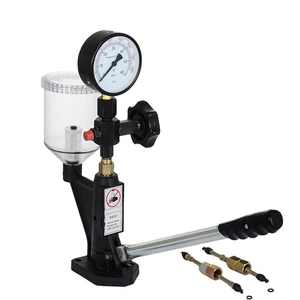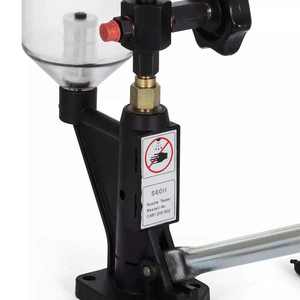
All categories
Featured selections
Trade Assurance
Buyer Central
Help Center
Get the app
Become a supplier

(214909 products available)












































Pump testing and calibration machines come in diverse configurations, suitably geared to the kind of pump that necessitates testing. These types include:
Hydraulic Tester
A hydraulic pump testing machine is used to test hydraulic pumps. The pump performance is assessed by monitoring the pressure and flow. If the hydraulic pump does not meet the specifications, the machine adjusts the parameters to help the pump meet the right standards. These testers are vital in industries like manufacturing.
Electric Pump Testing Rig
An electric pump testing rig tests electric pumps and checks their electrical and hydraulic performance. It measures flow, pressure, and energy efficiency. It is mainly used in laboratories and large-scale production lines to ensure product reliability.
Calibration Machine for Fuel Pumps
A calibration machine for fuel pumps is often used in the automotive industry. It tests and calibrates fuel pumps to ensure efficiency and safety. This machine simulates fuel system conditions, measuring flow rates, pressure, and accuracy. Any discrepancies in the performance of the fuel pump are indicative of the need for correction.
Submersible Pump Tester
This machine is helpful for testing submersible pumps, mainly in groundwater extraction. It measures pressure, water flow, and the pump's ability to work under pressure. Commonly found in water supply agencies, it helps verify pump performance before installation.
Centrifugal Pump Test Bed
A centrifugal pump test bed measures flow and efficiency. It assesses the performance of centrifugal pumps widely used in oil and gas, chemical processing, and water treatment industries. Data collection on the testbed helps in increasing efficiency and decreasing operational costs.
Positive Displacement Pump Tester
This tester checks the performance of positive displacement pumps. It assesses pressure, flow, and mechanical efficiency. It is often used in service providers and manufacturing plants to maintain and ensure the reliability of PD pumps.
The main role of a pump testing and calibration machine is to check the performance of various types of pumps. This aids in the identification of defects, thus ensuring the proper functioning of the equipment. Some of these machines are used for calibrating fuel pumps to maintain their efficiency. This is done by simulating the conditions of the system and measuring specific performance parameters.
Using a water pump test bench, users can measure the water flow rates or check the pump's output pressure. If any of these parameters deviate from the required standards, the performance will be low; in such instances, corrective measures, such as repairs or replacements, will be necessary.
Features of pump testing and calibration machines include:
The way these machines work depends on the kind of pump being tested. The hydraulic test bench works by checking how much pressure and flow a hydraulic pump can produce. It uses water to see how well the pump works. The fuel pump calibration machine checks fuel pumps by using special liquids. It makes sure the fuel pump gives the right amount of fuel to the engine.
This machine controls the pressure and flow for accuracy. It helps prevent damage during testing. Computers or software might be used to get clearer results. After the test, the machine's screen shows the results. Users then compare those results with standard numbers to see if the pump is working well enough.
Measuring instruments are crucial for maintaining reliable operations in many industries. The scenarios below highlight where these machines play an important role.
Hydraulic Pump Testing in Manufacturing
High-pressure hydraulic pumps are tested using a hydraulic tester in large manufacturing places. The machine helps check if the pump can handle pressure before the hydraulic pumps are installed in big machines. Finding problems with the pump early on helps avoid future expensive repairs.
Electric Pump Testing for Water Systems
A water supply company tests electric pumps using an electric pump testing rig. The machine ensures the pumps can move the right amount of water in pipelines. The company replaces any pump that does not meet the required standards.
Fuel Pump Calibration for Car Safety
Fuel pump calibrators are found in automotive garages and used to check and fix fuel pumps. A trained technician plugs the fuel pump into the machine. The machine then checks if the pump gives the right amount of fuel to the engine. It also helps the mechanic adjust the pump if needed to save on fuel and prevent engine damage.
Submersible Pump Testing Before Installation
A drilling company uses a submersible pump test machine to check pumps before putting them underground. The machine finds any problems with the pump early on. Testing the pumps first helps prevent problems while drilling and saves money.
Centrifugal Pump Efficiency Verification
A chemical plant uses a centrifugal pump test bed to make sure its pumps work well enough. The machine checks how much liquid the pump moves and how efficient it is. If any pumps do not perform well, the plant replaces or repairs them. This testing saves energy costs and prevents future breakdowns.
Regular Cleaning
Pumps and machines used for testing and calibrating should be cleaned often. This helps remove any fuel, water, or dirt left on them after use. Keeping things clean helps the machines work better and last a long time.
Checking Fluids
Fluids like oil and water are important for these machines. Users should check the amount of fluid and its condition regularly. Changing the fluid when needed keeps the machines from getting too hot and helps them run smoothly.
Inspecting Parts
Users should look at parts like hoses, seals, and valves every so often. Worn or damaged parts should be fixed or replaced. This prevents small issues from becoming big problems and helps the machines keep working well.
Lubricating Moving Parts
Certain machines have parts that move a lot, such as pumps and motors. Users should put grease or oil on these parts to reduce friction. Lubricating regularly helps stop the parts from wearing down and makes the machines more dependable.
Performing Calibration
Users should test the devices used to calibrate the machine often. This ensures the results are correct. Performing the calibrations will ensure each machine gives accurate results.
Installing New Sensors
Adding sensors that are better or newer can help the machines give more accurate scores. It can also allow users to keep track of more things, like temperature or speed. This would help the machines provide even more accurate results.
Using Software to Analyze Results
Going from old machines to modern digital systems can help testers be more efficient. Using computers to store and check the results is quicker than doing it by hand. Computers can also help make the testing process more precise.
Updating Materials
Users should consider updating the machines by replacing old parts with new, longer-lasting ones. Making this change will ensure the machines will work better and last longer for users.
Attending Training Programs
Locating training sessions for managers and technicians on the latest equipment is important. Attending these sessions helps everyone learn how to use new machines and software. This keeps testing fast and correct.
Spending on Upgrades
When makers release newer models with better features, owners should consider buying them. Having recent pump testers makes sure businesses stay current and efficient in testing.
FAQs done below address common questions regarding pump testing and calibration machines.
A1: Testing a pump reveals any problems with the pump. Catching issues early stops small mistakes from causing big ones later. This helps avoid expensive repairs and keeps things running safely.
A2: Calibrating a pump means making sure it works as efficiently as possible. Adjusting the pump ensures it gives the right output without wasting energy. This improves performance and saves on energy bills.
A3: The machine checks how much pressure and flow the pump can produce. This helps find problems before installation. It ensures the pump can handle tough tasks without breaking down.
A4: Users must regularly check the test machine's results to ensure they are accurate. Performing checks often helps spot small issues before they become big. Keeping the testers precise avoids mistakes in results.